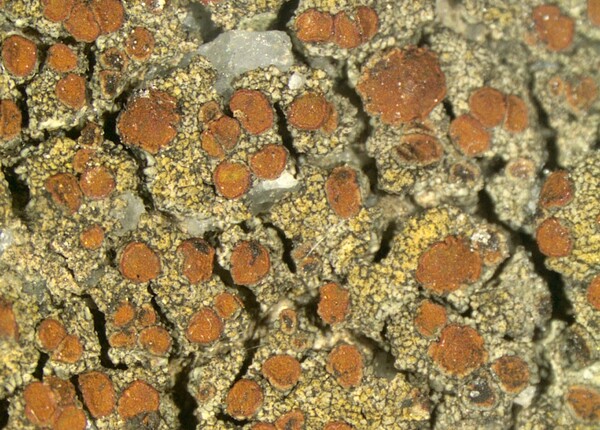Blastenia psychrophila Halıcı & Vondrák
in Vondrák & al., J. Syst. Evol. 58, 3: 320, 2019.
Synonyms: Caloplaca crenularia auct. ital. p.p.
Description: Thallus crustose, episubstratic, grey (exceptionally with a yellowish tinge), partly >100 μm thick, rarely with rough, isidia-like outgrowths. Apothecia biatorine/zeorine, rust-red, 0.7-1.1 mm across. Proper exciple prosoplectenchymatous, C+ purple; epithecium orange-brown, granular, K+ red, C-; hymenium colourless, not inspersed with oil droplets; paraphyses simple or sparingly branched and anastomosing, 1.5-3 μm thick in lower part, the apical cells usually wider; hypothecium colourless. Asci 8-spored, clavate, functionally unitunicate, apically thickened with a broad internal beak, the inner part of apex and external cap I+ blue, Teloschistes-type. Ascospores 2-celled, polarilocular, hyaline, ellipsoid (10-)13.5-19(-25) x 6-9 µm, the equatorial thickening (“septum”) c. 6 µm. Pycnidia red. Conidia bacilliform, rarely narrowly ellipsoid, 3-5 x 1-1.5 μm. Photobiont chlorococcoid. Spot tests: thallus K-, C-, KC-, P-; apothecia K+ red. Chemistry: non-chlorinated anthraquinones in apothecial disc, chlorinated anthraquinones in exciple; thallus without anthraquinones; Cinereorufa-green in thallus. For further details see Vondrák & al. (2020).
Growth form: Crustose
Substrata: rocks
Photobiont: green algae other than Trentepohlia
Reproductive strategy: mainly sexual
Commonnes-rarity: (info)
Alpine belt: rare
Subalpine belt: rare
Montane belt: very rare
Dry submediterranean belt: absent
Humid submediterranean belt: absent
Padanian area: absent
pH of the substrata:
1 2 3 4 5
Solar irradiation:
1 2 3 4 5
Aridity:
1 2 3 4 5
Eutrophication:
1 2 3 4 5
Poleotolerance:
0 1 2 3
Altitudinal distribution:
1 2 3 4 5 6
Rarity
absent
extremely rare
very rare
rare
rather rare
rather common
common
very common
extremely common
Loading data...
Occurrence data
Predictive map
Growth form: Crustose
Substrata: rocks
Photobiont: green algae other than Trentepohlia
Reproductive strategy: mainly sexual
Commonnes-rarity: (info)
Alpine belt: rare
Subalpine belt: rare
Montane belt: very rare
Dry submediterranean belt: absent
Humid submediterranean belt: absent
Padanian area: absent
pH of the substrata:
| 1 | 2 | 3 | 4 | 5 |
Solar irradiation:
| 1 | 2 | 3 | 4 | 5 |
Aridity:
| 1 | 2 | 3 | 4 | 5 |
Eutrophication:
| 1 | 2 | 3 | 4 | 5 |
Poleotolerance:
| 0 | 1 | 2 | 3 |
Altitudinal distribution:
| 1 | 2 | 3 | 4 | 5 | 6 |
Rarity
absent
extremely rare
very rare
rare
rather rare
rather common
common
very common
extremely common
Loading data...
Occurrence data
Predictive map







